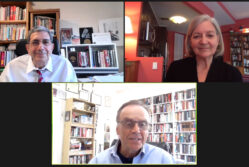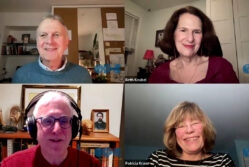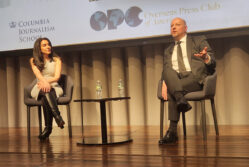
Women Covering War: Determination of Steel
When watching Edie Lederer, Tina Susman and Nicole Tung during the OPC-NYU discussion on November 8 on women covering war, they each had a presence that indicated they had never been asked, “are you sure?” These are three self-directed and determined women. They’ve had to be, and not just because war reporting is a field dominated by men, but because war reporting requires gut instinct and a singular drive, which each woman relayed when discussing covering conflict.
OPC member Lederer has covered war in Vietnam, the Middle East, Afghanistan, Bosnia and elsewhere. Susman is a former Baghdad bureau chief for the Los Angeles Times. Tung is a freelance photographer covering the Middle East and North Africa. The panel was moderated by Professor Mohamad Bazzi with an introduction by Pete Hamill.
All three women conceded their families had wished they’d gone for the Paris or Rome bureau. “I always wanted to cover conflict,”Susman said. “I grew up watching news and being a journalist looked like an exciting job. I knew I could do it and be good at it.”
Bazzi asked how the women prepared for covering conflict. Susman said she just showed up in Somalia. “I followed what the more experienced journalists were doing. Asked questions and went with my gut.”
Lederer said a chance encounter at a lunch with a comandante of a U.S. base led her to a day in the training field to learn about weapons and mines. “Off I went to Vietnam incredibly green,”she said. She also followed around the seasoned AP press corp for a year and learned to look for people who weren’t “war junkies”but who understood the politics and military dynamics and had a sense of what would be dangerous.
Tung said even though there are now classes and resources to prepare journalists entering conflict zones, she went into Libya without training. She ended up shadowing Jon Lee Anderson who gave her a flack jacket and helmet. She said it was a sobering lesson in how dangerous the job was when photographers Tim Hetherington and Chris Hondros were killed. Tung later took advantage of a RISC training course that instructs on first-aid in the field. “Not having a skill to make a tourniquet isn’t OK anymore,”she said.
Bazzi asked if they ever felt afraid while covering conflict. Lederer said sometimes it’s good to be afraid. “Fear makes you assess where you are, what you are doing, what risks are for you,”she said. She once had a 45-caliber pistol pointed at her temple by a customs agent in Afghanistan. “You have to be cool,”she said with a smile. “I wasn’t afraid until that night when I thought about what had happened.”
Susman said that being a woman has often been an asset as a reporter because she has her eye trained differently and sees stories where others might not, like fresh-flower businesses and gastric bypass operations in Baghdad at the height of the war. Had she ever covered a story and regretted it because of the risk? “Never,”she said. “I have the professionalism and clout with my editors to say, ‘no, I don’t want to do that, but how about I do this… .’”



